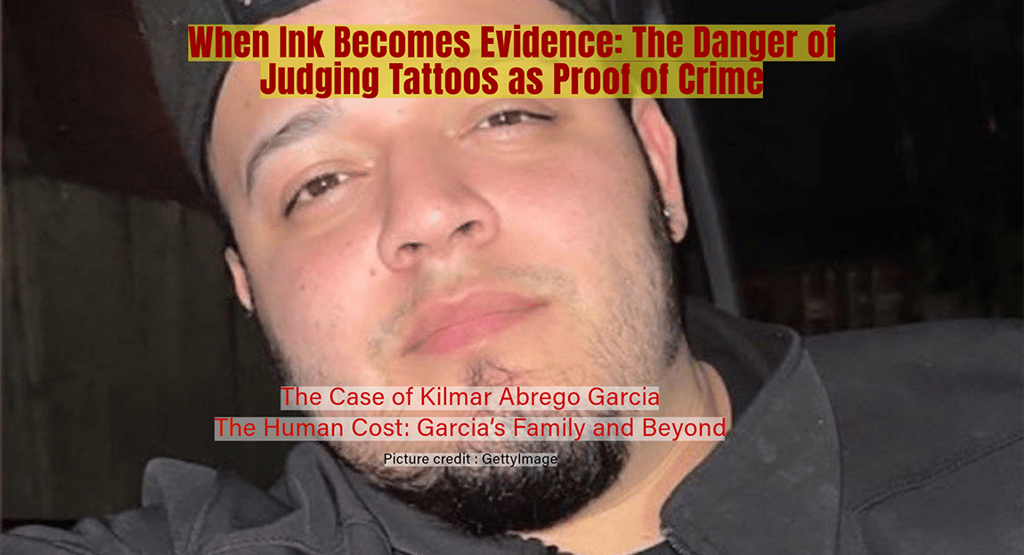When Ink Becomes Evidence: The Danger of Judging Tattoos as Proof of Crime
4/22/20253 min read


When Ink Becomes Evidence: The Danger of Judging Tattoos as Proof of Crime
In a world where self-expression often takes the form of tattoos, what happens when body art is mistaken for a criminal confession? The recent case of Kilmar Abrego Garcia, a 29-year-old Salvadoran deported from the U.S. to El Salvador’s notorious CECOT mega-prison, has sparked heated debate. Former President Donald Trump shared a photo of knuckles allegedly tattooed with “MS-13,” claiming it proves Garcia’s ties to the violent gang. But is a tattoo enough to brand someone a criminal? And what does it say about a justice system when a powerful leader can bypass due process with a single social media post?
The Case of Kilmar Abrego Garcia
Kilmar Abrego Garcia entered the U.S. illegally in 2011 at age 16, fleeing gang violence in El Salvador. By 2019, he was living in Maryland, married to a U.S. citizen, raising three children, and holding a work permit under a “withholding of removal” order. This legal protection, granted by an immigration judge, barred his deportation to El Salvador due to a credible fear of persecution by gangs like Barrio-18. Garcia had no criminal record in the U.S. or El Salvador, and his yearly ICE check-ins were uneventful.
On March 12, 2025, ICE detained Garcia during a traffic stop, alleging MS-13 ties based on a 2019 police report citing a confidential informant and his Chicago Bulls hat. Three days later, despite the 2019 court order, he was deported to CECOT, a prison known for human rights abuses. The Trump administration called it an “administrative error,” but later doubled down, with Trump posting a photo of tattooed knuckles to argue Garcia’s guilt. Garcia’s lawyers and wife, Jennifer Vasquez Sura, deny the gang allegations, noting the informant claimed ties to a New York MS-13 clique, where Garcia never lived. The Supreme Court has since ordered the U.S. to “facilitate” his return, but El Salvador’s President Nayib Bukele refuses to release him.
Tattoos as Evidence: A Flawed Approach
Trump’s post hinges on the assumption that tattoos are undeniable proof of criminality. The image shows knuckles with “MS-13” and small symbols, captioned to attack Democrats for defending Garcia. But tattoos are not confessions. Steven Dudley, an expert on MS-13, notes that while the gang has used symbols like the Chicago Bulls logo, such imagery is not exclusive to them. Misinterpreting tattoos risks condemning the innocent, especially when no criminal charges or convictions exist.
Consider Pete Hegseth, a former Fox News host and Trump’s nominee for Secretary of Defense. Hegseth has tattoos, including a Jerusalem cross and “Deus Vult” (Latin for “God wills it”), linked to his military service and Christian faith. Some critics have falsely tied these to white nationalism, showing how tattoos can be misconstrued. If Hegseth’s ink doesn’t make him a criminal, why should Garcia’s alleged tattoos, unverified as his, justify deportation without a trial?
The Global Context: Power and Prejudice
The U.S. isn’t alone in this. In El Salvador, Bukele’s regime has detained tens of thousands under a 2022 state of emergency, often using tattoos as evidence of gang ties. Many, like Garcia, face imprisonment without trials, their fates sealed by leaders wielding unchecked power. In Japan, tattoos are stigmatized due to historical yakuza ties, leading to discrimination against inked individuals. In Russia, prison tattoos can mark someone as a criminal, even post-rehabilitation. When leaders—whether Trump, Bukele, or others—use tattoos to bypass due process, they erode justice and amplify prejudice.
This practice raises a chilling question: If a tattoo can condemn someone without evidence, what protects anyone from arbitrary punishment? The U.S. Constitution emphasizes due process, yet Garcia’s case shows how executive power can sidestep it. A Bloomberg investigation found 90% of deportees to CECOT had no U.S. criminal record beyond minor infractions, suggesting a pattern of profiling based on appearance rather than proof.
The Human Cost: Garcia’s Family and Beyond
Garcia’s deportation has shattered his family. Vasquez Sura, now raising their disabled son and two stepchildren alone, told ABC News the “error” destroyed their happiness. The uncertainty of Garcia’s fate in CECOT, coupled with Bukele’s refusal to release him, leaves them in limbo. This isn’t just one family’s tragedy—it’s a warning of what happens when justice is replaced by snap judgments.
Toward a Fairer Future
Tattoos tell stories, not verdicts. Garcia’s case demands a return to due process: thorough investigations, transparent evidence, and fair hearings. Leaders must resist the temptation to weaponize appearances for political gain. The U.S. justice system, at its best, values evidence over optics—but only if we hold it accountable.
Thought Questions:
Should tattoos ever be used as evidence of criminality without corroborating proof? Why or why not?
How can the U.S. balance national security with due process in immigration cases like Garcia’s?
What role should social media play in shaping public perception of legal cases, especially when posted by powerful leaders?
hello@boncopia.com
+13286036419
© 2025. All rights reserved.